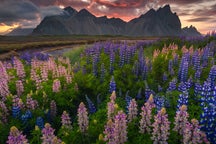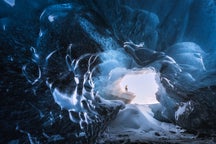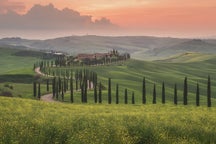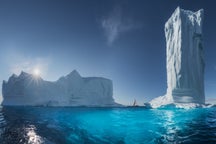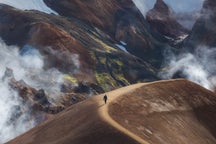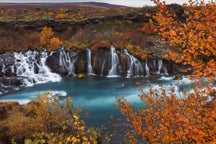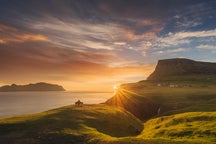
“Patagonia! She is a hard mistress. She casts her spell. An enchantress! She folds you in her arms and never lets go.”
- Discover The Ultimate Guide to Animals in Antarctica
- Check out this article on Understanding Metadata | EXIF for Landscape Photography
In this way, Bruce Chatwin describes one of the most beautiful and incredible regions of this Earth, Patagonia.
I would like to tell you how it feels like to walk in the prairies between cute guanacos and fleeting pumas, among speedy hawks of all kinds and colourful mountain peaks, among the crafty foxes of Patagonia and the majestic condors, all at the foot of the Andes, but I can't. I can't put all of this into words, nor can I even come close to narrating what it really feels like to be there.
Even if I can’t convey to you the same emotions that I felt while I was exploring those places, I’ll try to help you as much as I possibly can to plan your trip of a lifetime down there, at the southern end of this world. In this article, you'll learn all about the boundaries of Patagonia, when and where it is recommended to go there, what to pack and a few of its most beautiful locations for photography.
Where is Patagonia?
 Patagonia is a region between Chile and Argentina. Photo by: 'Leonardo Papèra'.
Patagonia is a region between Chile and Argentina. Photo by: 'Leonardo Papèra'.
First things first: where is “Patagonia”? Is it a province, a country or a town? Well, the answer is none of these.
When someone talks about Patagonia, they are referring to a specific region of South America which lies between two countries: Chile and Argentina. The boundaries of this region are naturally created by the Andes in the west and the south, deserts and grasslands in the east, extending north to the Rio Negro and Neuquèn provinces of Argentina as well as the Palena province in the Los Lagos region of Chile.

As you can see, the area that we are talking about is quite huge; you could probably spend a lifetime roaming around there without even seeing half of the region. Luckily, the area we are interested in for photography is much smaller than that. All of the most popular and famous photographic locations of Patagonia (we’ll talk about them later) lie within a range of 400-500km, so if pictures are all you are after, you won’t have to drive for thousands of kilometres between Argentina and Chile.
- See also: Patagonia Hiking Photo Adventure
When to Visit Patagonia
 Patagonia is beautiful throughout the seasons. Photo by: 'Leonardo Papèra'.
Patagonia is beautiful throughout the seasons. Photo by: 'Leonardo Papèra'.
Regardless of the time of the year you’ll be there, Patagonia will always offer you breathtaking views. There are some periods though that are slightly better than others for photography. In this chapter, I'll talk about what each season of the year has to offer and when is the best to visit.
Autumn
Okay, I’ll make it quick. Autumn is the best time of the year to visit Patagonia for photography. Temperatures are still not too rigid, you'll have plenty of light to hike during the day and last but not least, you’ll catch the wonderful autumn foliage in all of the locations. Trust me, the vibrancy of the colours that you'll witness down in Patagonia are unique. It's going to be hard to find those colours elsewhere in the world.
 Autumn is the best time to visit Patagonia. Photo by: 'Leonardo Papèra'.
Autumn is the best time to visit Patagonia. Photo by: 'Leonardo Papèra'.
Meanwhile, all of the hotels, campsites and restaurants will still be open. There will be far fewer tourists around, since generally, the hiking season is summer. As you can see, there are plenty of reasons to elect autumn as the best season to visit Patagonia!
Winter
Winter is beautiful too, with high chances of catching some snow in many locations but you should be prepared to face the harshness of the cold season in Patagonia, since that’s not a joke!
 Winter is beautiful in Patagonia but also the most dangerous time to travel. Photo by: 'Leonardo Papèra'.
Winter is beautiful in Patagonia but also the most dangerous time to travel. Photo by: 'Leonardo Papèra'.
You should be aware that in winter, most of the huts, campsites, hotels and restaurants will be closed; temperatures can be really low and strong winds should always be taken into consideration. Many trails will become dangerous and it is recommended that only expert hikers or mountaineers attempt them.
While you can take some incredibly beautiful photos during winter in Patagonia, the effort required to take those shots will be very high, much higher than the other seasons!
Spring
This is probably the least considered season when people think about traveling in Patagonia. In early spring, everything will still be closed for the winter season and you may find melting snow in many locations. Temperatures will be similar to winter, warming as the season progresses. In late spring, the kick-off of the hiking season begins and tourists will start to flow in.
I recommend visiting Patagonia in late spring, if that’s the only time of the year that you can travel, so that you won’t have any problems with campsites, accommodation and trails; oh, and you’ll have more daylight too!
Summer
If you are into hiking and exploring as much as you are into photography, then this may be the best time of the year for you to visit Patagonia. With long days you’ll have enough time to do not just photography but also other activities, visit more places and take longer trails to explore the wilderness of the area. The temperature will be warmer and you can easily sleep under the stars in some of the many campsites that will be open during the season.
What to Pack
 Packing for a Patagonia trip involves a bit of thinking. Photo by: 'Leonardo Papèra'.
Packing for a Patagonia trip involves a bit of thinking. Photo by: 'Leonardo Papèra'.
Planning what to bring on an adventure like a Patagonia trip is not an easy thing to do. Let's go through all the necessary stuff that I recommend you bring on this trip, in terms of photography as well as other much-needed gear.
Non-Photographic Equipment
Clothing
At most of the photography locations that you’ll visit, you’ll need the kind of clothes that you would use in any other mountainous place around the world: fleece meshes, thermal meshes and waterproof pants are some of the suggested items that you bring.
Obviously, the amount of clothing that you'll need to pack will depend on the season you are planning to travel in. During winter, you’ll need more – and likely heavier – clothing than in summer, when breathable t-shirts may be a valid option if you plan to hike a lot.
Camping Gear
Patagonia is one of the best places on Earth to go on a camping trip; not the kind of camping that requires an RV but the kind of camping that requires a tent and a sleeping bag (as well as many other things). I've decided to include this section because I think that 90% of you who are reading this article will probably spend at least a few nights under the starry sky of Patagonia.
Let’s start from the tent: if you plan to stay out in the wilderness for a few nights, then this is the first thing that you should think about. In Patagonia, the wind is one of the biggest problems when camping. As such, you should choose a tent that will protect you from strong winds as well as rain and hail.
Personally, I use a Camp Minima 3 SL (or 1 SL, depending on the length of the hike), and it has been great even in the worst possible conditions. The 1 SL can be too small for many people, so I recommend going for at least the 2 SL if you want some space. By the way, I’m not sponsored, nor do I have any collaboration with the manufacturer. This is just my honest opinion.
The next piece of gear that you should think about when camping is your sleeping bag. When choosing a sleeping bag, be sure to keep a wide margin on the lowest comfort temperature. For example, let’s say that the minimum predicted temperatures in Patagonia will be around 3°C. You should choose a sleeping bag with a minimum comfort temperature lower than that by a few degrees at least, so that you won’t be too cold during the night. When you're out in the elements, it's easy to get cold but it’s far harder to warm yourself up, so remember this general tip when you are in the selection process.
Other important pieces of gear that I would recommend you put in your backpack are a sleeping mat for more comfort and a camping stove to cook something hot to eat at the end of the day.
Photography Equipment
Now, let’s talk about the important stuff: what kind of gear do you need for taking photos in Patagonia?
Let’s start by saying that the weather will be exactly what you would expect at the southernmost end of the world: atrocious. It’s common to catch a few days of continuous storms and your equipment should be ready to work under those kinds of weather conditions, unless you want to be stuck in your tent or hotel for many days in a row. As such, a weather-sealed camera and lenses are highly recommended!
Camera
There are not many things to say about the camera apart from that it needs to be weather-sealed. Aside from that, any DSLR or mirrorless model will do the job. I recommend bringing along a full-frame camera if you plan to shoot landscapes more than wildlife, as they have an overall better image quality especially at low ISOs. A high-end APS-C camera will also work well if you are travelling in Patagonia for its incredible wildlife, since the quality will still be excellent and you can take advantage of the 1.5x crop factor.
Lenses
My personal recommendation here is to never leave for a Patagonia trip without being covered across all of the most important focal lengths. You’ll probably end up using all of them!
Wide Angle Lens
If you mainly shoot landscapes, then this is going to be your workhorse for the whole trip. There are endless foregrounds to include in your pictures in Patagonia and the mountains work perfectly with a wide angle lens (from 14mm to 24mm).
Standard Zoom Lens
Even if personally I love to shoot mountainscapes with a wide angle lens, at the end of each trip I have noticed that a good 40% of the photos were taken with my standard zoom lens (24-120mm in my case). The point is to never leave your standard zoom at home. Never. You are going to need it!
Telephoto Lens
It goes without saying that if you are a wildlife photographer, then this should be the first lens you put in your bag. Even if you are not strictly a wildlife photographer though, a telephoto lens can be useful in many cases. Check out the shot below. Without my 150-600mm, I could never have taken a shot like that.
 A telephoto lens will allow you to capture close-up shots of the mountain peaks like this. Photo by: 'Leonardo Papèra'.
A telephoto lens will allow you to capture close-up shots of the mountain peaks like this. Photo by: 'Leonardo Papèra'.
Tripod
I’ll never get tired of writing how fundamental it is to have a good, sturdy tripod with you when travelling in places like Patagonia. You’ll focus a lot more on the composition and you’ll be able to use an array of techniques that you simply can't do without a tripod, such as HDR, multiple exposures, bracketing and long exposures. Even if you don’t care about compositions or these types of photography techniques, a tripod will give you a steady support for your camera. For me, it's definitely a must-have when visiting Patagonia!
Filters
Sometimes they can be quite useless, sometimes they turn a boring photo into an incredible shot: overall, my tip is to bring at least a set of neutral density (ND) filters with you to Patagonia.
You are going to shoot moving subjects (water, clouds, trees, etc) quite a lot down there and if you want to capture the movement of those subjects, the only way to do it is by mounting an ND filter on your lens. Long exposures can result in some incredible effects, so you’ll probably want to play with them at least a few times during the trip!
Other Accessories
Torch / Headlamp / Flashlight
A source of light can be really useful if you plan to hike in the darkness (before sunrise or after sunset), so be sure to always a torch, headlamp or flashlight in your bag.
Spare Batteries
One battery is never enough. Remember that you’ll be out in the wilderness, perhaps for a night, maybe for a week, but you’ll need a few spare batteries in any case. If you don’t want to bring a lot of them, you can bring a powerbank with you to charge the ones that you have.
Remote Control
A remote trigger release can be useful for long exposures or in general when shooting in Bulb mode. You can choose between a more complicated intervalometer with a screen and many features or a simple cable / bluetooth remote with just the shutter button. Since I like simple things, I went for the latter but feel free to choose the one you prefer the most!
 A remote trigger release is great for minimising camera shake. Photo by: 'Leonardo Papèra'.
A remote trigger release is great for minimising camera shake. Photo by: 'Leonardo Papèra'.
Top Photography Locations of Patagonia
There are two main areas in Patagonia where the majority of the photos you see online have been taken: the Torres del Paine National Park in Chile and the Los Glaciares National Park in Argentina. Let’s talk more about these two fabulous locations for photography.
Torres del Paine National Park
 Torres del Paine National Park is an extraordinary place for landscape photography. Photo by: 'Leonardo Papèra'.
Torres del Paine National Park is an extraordinary place for landscape photography. Photo by: 'Leonardo Papèra'.
If you are looking to book a Patagonia trip, then chances are high that you have already heard about the Torres del Paine National Park. It is one of the most incredible spots for photography in the entire region. The park is famous for its unique shaped mountains, blue icebergs calved from the nearby glaciers and the “pampas”, which are the classic Patagonian steppe.
Your options for visiting the park and how much time you spend there are endless:
-
There are many multi-day hiking options (the most famous trail is the 'W circuit') with pre-arranged campsites along the trails. There is no wild-camping in the park and you must camp in the designed campsites.
-
You can stay in one of the few campsites along the main road that crosses the park: I suggest 'Camping Tahoe;, which will allow you to sleep near the famous Tahoe lake. This is one of the most popular photography spots and it’s not expensive at all.
-
You can stay in one of the hotels inside the park, though obviously this will be the most expensive option.
In terms of photography, you’ll have to decide whether you want to catch the sunrise in the Lake Tahoe area, go photo-hunting for the beautiful puma, or hike on a trail to catch the sunset behind the Cuernos del Paine with dead trees in the foreground. Well, I guess these are the kind of choices that everybody would love to have in their life, right?
Small tip: If you aim to shoot the Cuernos from up close with some of the famous dead trees in the foreground, then you should take the Mirador Cuernos trail, which will take you through the famous 'dead forests' until the Nordenskjold lake. Please remain on the trail in this area as the vegetation there is really fragile.
 Stay on marked trails, even when you are taking shots of the dead trees like this. The vegetation in Patagonia is very fragile. Photo by: 'Leonardo Papèra'.
Stay on marked trails, even when you are taking shots of the dead trees like this. The vegetation in Patagonia is very fragile. Photo by: 'Leonardo Papèra'.
Los Glaciares National Park
To visit the Los Glaciares National Park, you’ll have to cross the Argentine border, so be sure to have your passport with us as well as the car documentation for border-crossing in case you are driving. I'll give you some information now about the three main locations where you should absolutely go for photography when visiting this park: the Perito Moreno glacier, Mount Fitz Roy and the Cerro Torre.
Perito Moreno
 Perito Moreno is one of the few glaciers in the world that is still growing. Photo by: 'Leonardo Papèra'.
Perito Moreno is one of the few glaciers in the world that is still growing. Photo by: 'Leonardo Papèra'.
The Perito Moreno is one of the few growing glaciers in the world and it’s nothing short of incredible! The size of this glacier will leave you speechless when you stand in front of it. You should know that the glacier is part of the park and has opening hours and an entrance fee. You can check on the official website of the park for this information, as it may vary depending on the season you’ll be there.
You’ll find the Perito Moreno approximately 80km from El Calafate, which is also the nearest town.
Fitz Roy Mountain
 Mount Fitz Roy is a popular location for landscape photography. Photo by: 'Leonardo Papèra'.
Mount Fitz Roy is a popular location for landscape photography. Photo by: 'Leonardo Papèra'.
I bet you were looking forward to this, eh? The Fitz Roy is undoubtedly one of the most beautiful mountains of Patagonia, if not the whole planet. Those rugged peaks are one of the main reasons so many photographers want to travel to the end of the world.
To visit the Fitz Roy, you should head to El Chalten, a small town in the Santa Cruz province of Argentina. From El Chalten, take the 8-mile trail that leads to the Campamento Poincenot. You can either choose to stay at the basecamp for a few nights so that you don’t have to hike back and forth every day, or stay in a hotel downtown. My tip is to choose the first option: you’ll enjoy more of the wilderness and you’ll be closer to all the photography locations. Many of the photo spots are really close to the campsite, though you’ll have to walk a little bit more to reach a few of the others, including Laguna Sucia (in the photo below) and Laguna de los Tres. Regarding Laguna Sucia, you should advise the local rangers that you will be going to hike there, since the official trail is closed and it’s considered quite dangerous.
 You should advise the local rangers if you will be travelling to Laguna Sucia. Photo by: 'Leonardo Papèra'.
You should advise the local rangers if you will be travelling to Laguna Sucia. Photo by: 'Leonardo Papèra'.
Cerro Torre
The spikes of Cerro Torre are another incredible view that only a place like Patagonia can offer. To visit what is widely-considered to be the most photogenic mountain of the world, you will need to start your adventure from El Chalten. This time though, instead of taking the Campamento Poincenot trail, you should head instead to the Campamento Agostini. This hike is slightly easier and shorter than the hike to Fitz Roy but it will still take you around three hours to reach the campsite.
The two campsites are connected by a trail, so you can plan to camp for a few nights at the Poincenot campsite and then move to the Agostini (or viceversa) without returning to town.
As for the Fitz Roy, most of the photo locations can be found easily around the Agostini campsite, with the river flowing close by and the Laguna Torre just 10 minutes away!
- See also: 12 Day Greenland Photo Expedition
Useful Tips for Travelling in Patagonia
 Travelling in Patagonia is not as straight-forward as it seems. Photo by: 'Leonardo Papèra'.
Travelling in Patagonia is not as straight-forward as it seems. Photo by: 'Leonardo Papèra'.
Car Documentation
Let’s start by clearing this up: one of the trickiest things to do during the whole trip will probably be the border-crossing if you have rented your own car. There are some strict regulations between Chile and Argentina, especially about food, so be prepared to have your car examined scrupulously when you arrive at the border. The car also needs to have specific documentation for border-crossing at the ready, so you should warn the car rental company beforehand if you've chosen to drive between Chile and Argentina. Many car rental companies do not offer the possibility to cross borders, so ask before you book!
Language
The official language, both for Chile and Argentina, is Spanish. In big cities, most people will understand and speak in English but you may have some difficulties communcating in the most remote places or in the parks.
Money and Currency
Chile and Argentina have two different currencies: the first one has the Chilean Peso, while the latter uses the Argentine Peso. Credit or debit cards are accepted in cities and towns but it’s always a good idea to bring some cash with you, as electronic payments may not always work.
 Make sure you have both currencies, cash and cards with you to ensure that you'll have access to your money at all times. Photo by: 'Leonardo Papèra'.
Make sure you have both currencies, cash and cards with you to ensure that you'll have access to your money at all times. Photo by: 'Leonardo Papèra'.
Wifi and Internet
Patagonia will be a nice way to unplug a little bit from everyday’s life, as WiFi and/or Internet connections are often not available in many locations.
In cities and towns, you won’t have any problems with Internet connection or WiFi, which are both available in most hotels and restaurants.
In Torres del Paine, you probably won’t have phone signal while at hotels and campsites, the WiFi may be really slow.
In Argentina, especially at the Campamento Poincenot and Agostini, you won’t have any WiFi or Internet connection at all, so be prepared to be off the grid for a few days!
 WiFi and Internet are not readily available in Patagonia so be prepared to get off the grid for a few days! Photo by: 'Leonardo Papèra'.
WiFi and Internet are not readily available in Patagonia so be prepared to get off the grid for a few days! Photo by: 'Leonardo Papèra'.
In conclusion, I'd like to say that Patagonia has some of the most raw and astonishing views I’ve ever witnessed in my own life: driving through the pampas, seeing those imposing mountains growing on the horizon, observing the condors flying high above the Andes.. I could go on forever. The number of visual memories that I have from my Patagonian trips is huge; the only way you can really understand what I mean when I say that to travel at the end of the world is a once in a lifetime experience is, well.. to go there and witness it all with your own eyes!
About the author: Leonardo Papèra is a landscape photographer based in Italy. You can find more of his work on his website or by following him on Instagram.
Practice your HDR photography skills in-field on this 8 Day Summer Photography Workshop in Iceland! Learn from the best photography guides as you explore new boundaries.





